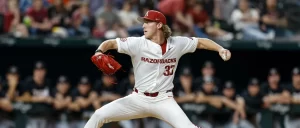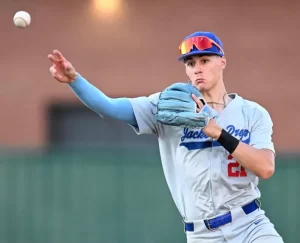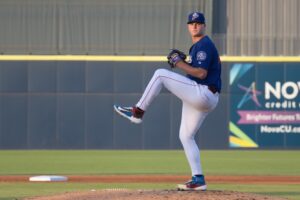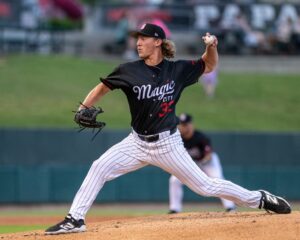Draft Preview: Kyle Freeland
Kyle Freeland
School: Evansville
Position: LHSP
Height/Weight: 6‘4”, 190
B/T: L/L
D.O.B.: 05/14/1993
Previously Drafted: 2011- 35 (1081) Philadelphia Phillies
Scouting Reports:
High School:
Out of high school Freeland was seen as a projectable lefty throwing in the high 80’s, but the Phillies could not sign him as a 35th round pick.
College:
Control may be Freeland’s best tool, which Baseball America calls “plus-plus” and his command is not too far behind either. Freeland features two potential plus pitches in his fastball and slider. The fastball features great sink and should generate a lot of ground balls. He can run the fastball up to 96 when needed, but typically sits low 90’s and it can be strikeout pitch for him. BA calls his slider a “hard slider in the 85-86 mph range when he’s right. The slider is lethal to lefthanded hitters.” Freeland also features a change and curve that both have the potential to be solid average pitches. Some scouting reports have noted that his delivery is not great and it could prevent him from being a starter long-term, but as BA notes “he has shown the athleticism to repeat it and throws a high volume of quality strikes.”
Baseball America’s Clint Longenecker had high praise for Freeland’s fastball after watching him in early April. “All three of Freeland’s fastball components (velocity, life and command) were at least plus. He showed the ability to get swings and misses with his fastball, producing six fastball whiffs on the day. His fastball sat 91-93 mph and touched 94-95, and he held that velocity throughout his nine innings and 97 pitches. Using both a two-seamer and four-seamer, Freeland showed varied fastball movement in every direction, featuring explosive cut and glove-side run on his four-seamer and arm-side run on his two-seamer. He produces downhill plane and sink, pitching in the lower half of the zone on both outer-thirds of the plate.”
“Batters react to Freeland’s fastball as if he’s throwing harder than 90-93 mph, because he has some deception in his delivery and the pitch has heavy life, and he can reach 95-96. He throws a true slider in the low 80s and can turn it into more of a mid-80s cutter at times. He’ll also display an average changeup at times, getting good sink on it. Freeland throws from a lower arm angle and features more effort in his delivery than scouts like to see in a starter”. –MLB.com
“Good fastball and ability to manipulate slider as well as offering a change make him look like a mid-rotation arm, maybe a #2 starter.” –MinorLeagueBall
Scouting Grades:
Note: these grades are my summations based on all readily available scouting information from sources such as Baseball America, MLB.com and ESPN (Present/Future, 20-80 scale):
Fastball: 55/65
Slider: 50/60
Change: 45/50
Curve: 45/50
Command: 50/60
Overall: 60
Prospect Overview and Future Outlook:
If the Sox want a “safer” college arm I like the prospect of Freeland over Aaron Nola. Freeland has more swing and miss potential in his repertoire through his plus slider. I like the ground ball potential of his sinking fastball also. Nola is definitely more polished and closer to being Major League ready, but I think Freeland may have a higher ceiling, while probably not needing a huge amount of time in the Minors either.
Freeland could be a very good #3 starter, or possible #2 if everything works out for him with two plus pitches and plus command. The changeup will need to improve further for Freeland to hit this top end projection though. His command and advanced repertoire should allow Freeland to move quickly through the system and he could be one of the fastest starters to reach MLB. He hasn’t been linked to the Sox in the same way that Nola has, and it would certainly be a shock if the Sox take Freeland tomorrow, but that doesn’t mean he’s not being considered for the pick.






